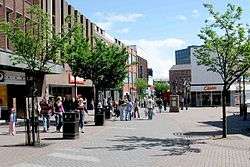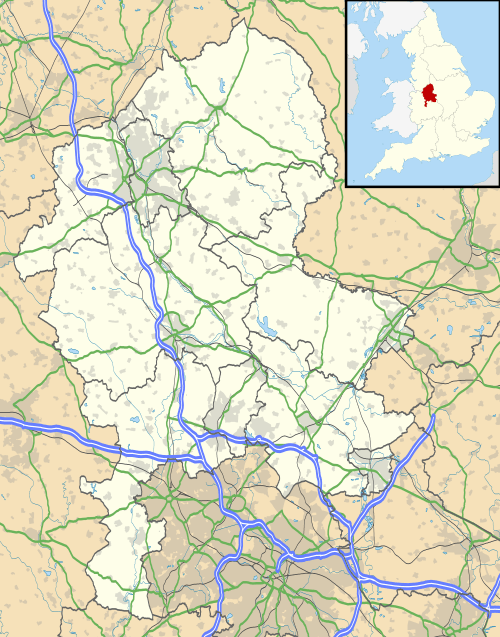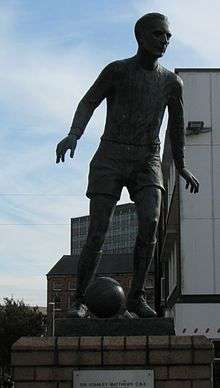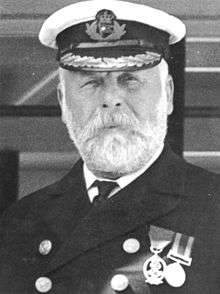Hanley, Staffordshire
Hanley, in Staffordshire, England, is a constituent town of the City of Stoke-on-Trent. Hanley was incorporated as a municipal borough in 1857 and became a county borough with the passage of the Local Government Act 1888. In 1910, along with Burslem, Tunstall, Fenton, Longton and Stoke-upon-Trent it was federated into the county borough of Stoke-on-Trent. Hanley was the only one of the six towns to be a county borough before the merger; its status was transferred to the enlarged borough. In 1925, following the granting of city status, it became one of the six towns that constitute the City of Stoke-on-Trent.
| Hanley | |
|---|---|
 Central Hanley, looking south along Town Road showing (centre right) the statue of Sir Stanley Matthews | |
 Hanley Location within Staffordshire | |
| OS grid reference | SJ880480 |
| Unitary authority | |
| Ceremonial county | |
| Region | |
| Country | England |
| Sovereign state | United Kingdom |
| Post town | STOKE-ON-TRENT |
| Postcode district | ST1 |
| Dialling code | 01782 |
| Police | Staffordshire |
| Fire | Staffordshire |
| Ambulance | West Midlands |
| UK Parliament | |
Hanley is the de facto city centre having long been the commercial hub of the city of Stoke-on-Trent. It is home to the Potteries Shopping Centre and many high street chain stores.
History
Etymology
The name Hanley comes from either "haer lea", meaning "high meadow", or "heah lea" meaning "rock meadow".
Coal mining
At one time, there were many coal mines in North Staffordshire. Hanley Deep Pit was opened in 1854. It was the deepest pit in the North Staffordshire coalfield, reaching a depth of 1500 feet. At its peak in the 1930s it employed some 2000 men and boys often producing 9000 tons of coal a week. The pit was closed in 1962 but much of the headgear and spoilheaps were left in situ. Then, in the 1980s, the original site was cleared, landscaped and converted into Hanley Forest Park.[1][2] Coal miners in the Hanley and Longton area ignited the 1842 General Strike and associated Pottery Riots. The College Road drill hall was completed in 1903.[3]
Garden Festival
The 1986 Stoke-on-Trent Garden Festival led to the reclamation of large areas of land west of the city centre area – including the former Shelton steelworks, which had been derelict since 1978. Ironically, when the Garden Festival closed, the land remained derelict for some time, before being re-developed partly into public parkland and partly for retail and leisure.
Public transport
In 2013, a brand new and modern bus station opened in Hanley. This replaced the former bus station, on Lichfield Street. The new bus station is the first stage in the regeneration project which will see the previous bus station demolished, and replaced with a new centre consisting of shops, restaurants and a cinema. The new bus station is smaller than its predecessor, and has seen various routes in and out of the city changed to accommodate the location of the new bus station. The bus station features a sheltered waiting area, Spar shop, cafe and toilets, is covered by CCTV, and has digital timetables showing information on travel times for the day, as well as Now/Next above the entrance to each bay. Access to the station is controlled by automatic doors, at both the pedestrian entrance and coach bays.
The new bus station links Hanley with towns in North Staffordshire, as well as Buxton, Crewe and Stafford. Most services are run by First Potteries, though there are a number of smaller independent operators, such as Wardle Transport, D&G Bus, and Arriva Midlands. In addition, National Express Coaches connect Hanley with destinations including London, Birmingham, Liverpool and Manchester, with additional seasonal services to holiday destinations. As part of the redevelopment of the town and wider city, a new bus interchange will be built on John Street, allowing the current station to be demolished to make room for further redevelopment of the town.
Hanley no longer has a railway station but there was once one located on Trinity Street, on the Potteries Loop Line, which was opened by the North Staffordshire Railway for passengers on 13 July 1864.[4] The station survived for 100 years – it was closed in 1964, as part of the Beeching Axe, and the land is now a car park.
Hanley is also connected to the waterways network; it meets the Trent and Mersey Canal at Festival Park, it is also connected to the east of the country via the Cauldon Canal.
Cultural sites
_(14586934407).jpg)
Hanley also offers several cultural facilities such as the Potteries Museum & Art Gallery (a large ceramics collection, and restored Spitfire), the Victoria Hall, the Regent Theatre, BBC Radio Stoke's Open Centre and studios, while Piccadilly hosts the annual Sanity Fair and French Market events. Hanley is also the location of Stoke Pride, an annual pride event for LGBT people of the city.
Religion
Christian Churches and Chapels in Hanley include: Bethel Evangelical Free Church (Newhall Street), Bethesda Town Mission (Jasper Street), Congregational Independent Tabernacle Church (High Street), Elim Church (Bucknall Old Road corner of Mynors Street, Northwood), Etruria Wesleyan Chapel (Etruria Old Road, Etruria), Holy Trinity C of E (Lower Mayer Street, Northwood), Providence Methodist Church (Junction of Town Road, and Hulton Street), St. John's C of E (Town Road, Hanley), St. Luke's C of E (Wellington Terrace), St. Mark's C of E (Broad Street, Shelton), St. Matthew's C of E (Birches Head), Sacred Heart RC (Jasper Street), Trinity Methodist (Keelings Road, Northwood), and St Simon and St Jude (Seaford Street, College (was Victoria) Road, Shelton).
Notable people


- Joseph Glass (fl.1670-1701 at least), potter
- Henry Heath (1828–1908) was a Latter-day Saint (Mormon) pioneer, explorer, settler and lawman in the frontier Utah Territory.
- Sarah Benett (1850-1924), Suffragette, member of the WSPU and social reformer worked in Hanley
- Edward Smith (1850–1912) Merchant Navy officer, captain of the RMS Titanic, who went down with the ship.
- Sir Albert Edward Bowen, 1st Baronet (1858–1924) businessman,[5] spent much of his life in Argentina.
- Arnold Bennett (1867–1931) writer and novelist,[6] but he also worked in the theatre, journalism, propaganda and films.
- Mabel Mary Spanton (1874–1940) landscape painter, worked in watercolour.
- Frederick Hurten Rhead (1880–1942) ceramicist [7] and a major figure in the Arts and Crafts movement.
- Raymond Coxon (1896–1997) artist,[8] had retrospective exhibition at the Potteries Museum & Art Gallery in 1987.
- George Henry Evans Hopkins OBE (1898–1973) entomologist [9]
- Henry Joseph Gallagher DCM (1914 – 1988) was awarded the Distinguished Conduct Medal for his gallantry during the Korean War.
- John Forrester (1924–2007) Labour Party politician,[10] MP for Stoke North 1966-1987.
- Harold Perkin (1926–2004) social historian [11] and founder of the Social History Society (1976).
- Jeff Kent (born 1951) academic,[12] musician, author and historian.
Sport
- Bill Rowley (1865–1939) footballer,[13] 124 appearances for Stoke City F.C. as goalkeeper.
- Horace Austerberry (1868–1946) football manager,[14] managed Stoke City F.C. 1897-1908.
- Alf Underwood (1869–1928) footballer,[15] played 130 times for Stoke City F.C.
- Thomas Holford (1878–1964) footballer,[16] 474 appearances for Stoke City F.C. Manchester City F.C., and Port Vale F.C.
- Arthur Box (1884–1960) footballer who played as a goalkeeper, over 100 appearances for Port Vale F.C., Stoke City F.C. and Birmingham City F.C.
- Sir Stanley Matthews, CBE (1915–2000) footballer,[17] one of the greatest players of the British game, 693 appearances for Stoke City F.C. and Blackpool F.C.
- Les West (born 1943) cyclist,[18] dominant figure during the 1960 and 1970's
- Terry Alcock, (born 1946) former footballer,[19] played 330 league games mainly for Port Vale F.C. and Blackpool F.C.
References
- Pictures of Hanley Deep Pit Archived 24 October 2007 at the Wayback Machine
- History of Hanley Deep Pit from local newspaper extracts Archived 24 October 2007 at the Wayback Machine
- "Hanley". The Drill Hall Project. Retrieved 29 September 2017.
- The North Staffordshire Railway Rex Christiansen & R. W. Miller. David & Charles Newton Abbot 1971 p. 79
- "No. 32178", The London Gazette (Supplement), 1 January 1921, p.2 retrieved 19 February 2018
- Arnold Bennett: The Edwardian David Bowie?, BBC News, Entertainment & Arts, 23 June 2014 retrieved 19 February 2018
- Frederick Hurten Rhead, www.pottery-english.com website retrieved 19 February 2018
- Painting(s) by or after Raymond Coxon, at the Art UK site retrieved 19 February 2018
- International Society of Phthirapterists (ISoP), Hopkins, G.H.E retrieved 19 February 2018
- UK Parliament website, John Forrester, MP, 31 March 1966 – 11 June 1987 retrieved 19 February 2018
- Institute of Historical Research, University of London, Perkin, Harold (1926–2004) retrieved 19 February 2018
- The Stone and Eccleshall Gazette, 9 October 2015, A man in high places retrieved 19 February 2018
- Bill Rowley at Englandstats.com retrieved 19 February 2018
- Stoke City managers at stokecityfc.com retrieved 19 February 2018
- Underwood, Alf, National Football Teams retrieved 19 February 2018
- SoccerBase Database retrieved 19 February 2018
- SoccerBase Database retrieved 19 February 2018
- The Telegraph, 30 Aug 2004, West still hooked on adrenalin retrieved 19 February 2018
- Portland Timbers, USA, stats retrieved 19 February 2018
